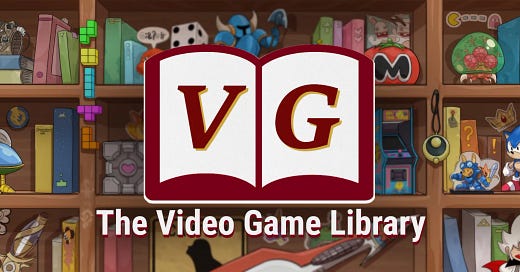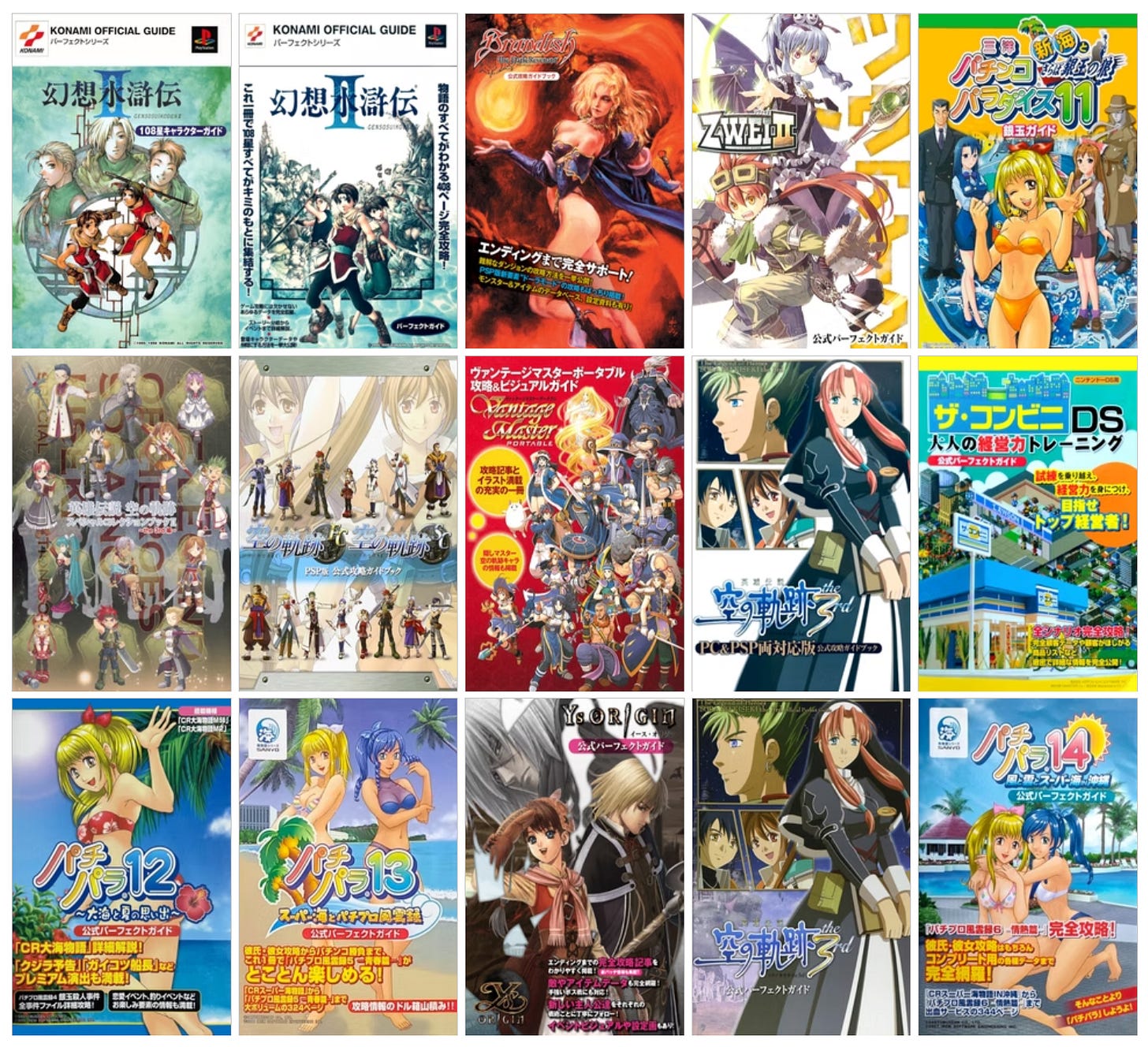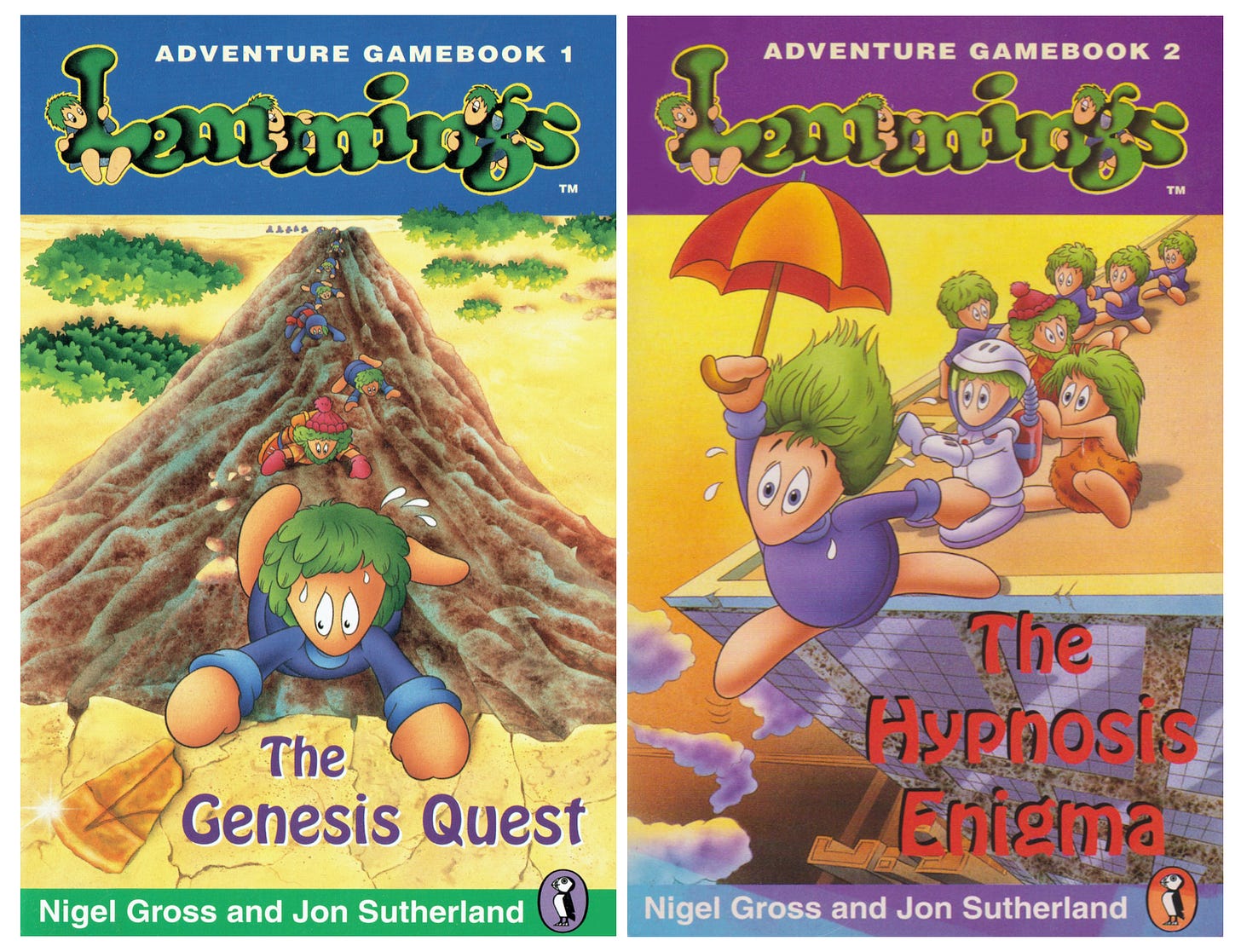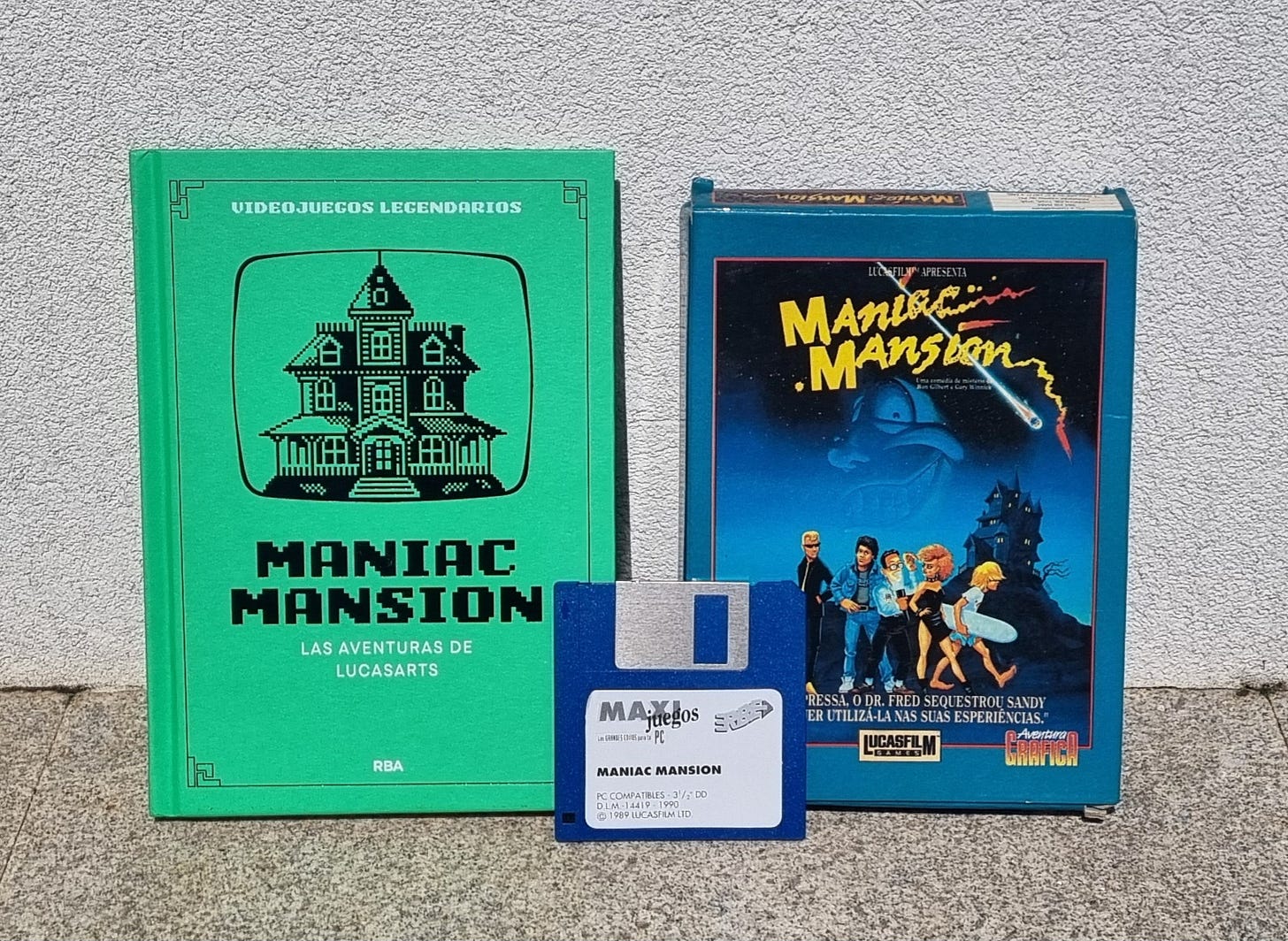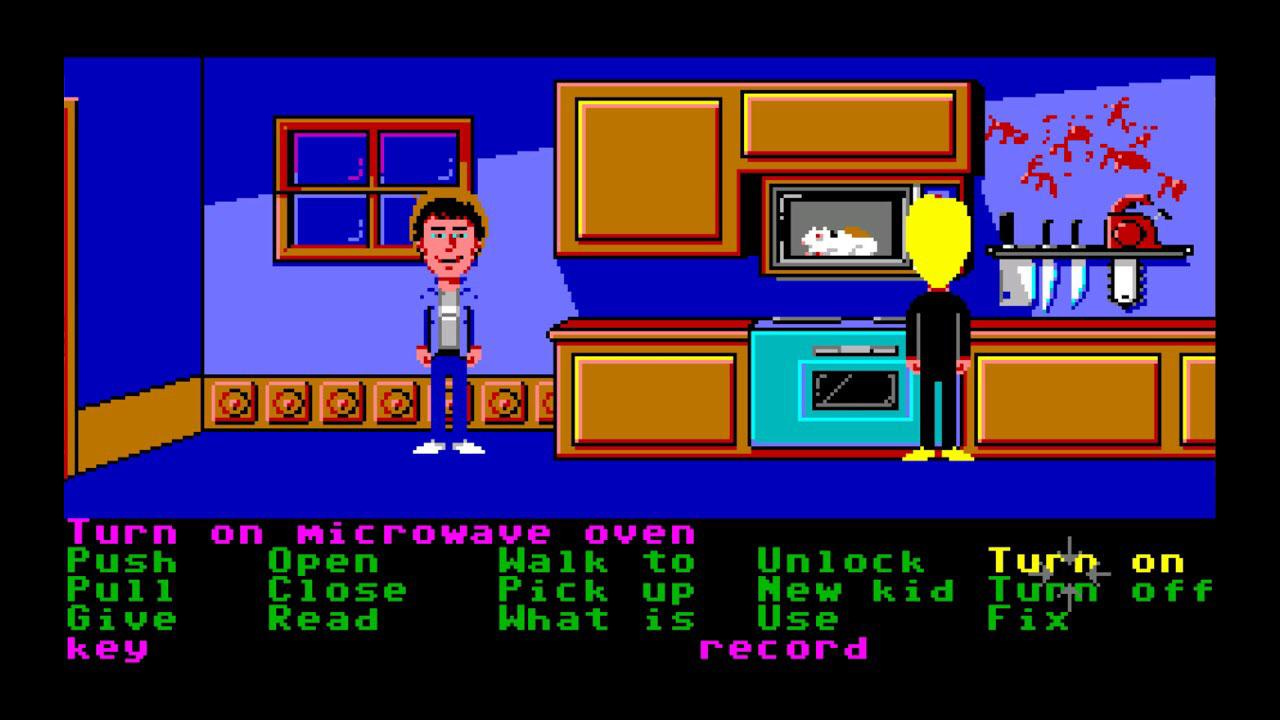The Video Game Library Newsletter - Vol. #006
THE biggest week for video game books so far: Career Tips, Kickstarters, FREE comics and a peek at one of my favourite GTA books. Plus, a great interview on a new LucasArts book!
Welcome back to The Video Game Library Newsletter!
I hope your shelves are holding up, because this is, by far, the most packed edition of 2025 to-date. With new books dropping, Kickstarter campaigns launching, Free Comic Book Day specials, artbook reveals, international releases, and collector’s bundles galore — this week has had a little bit of everything.
Grab a drink, queue up some chiptunes, and settle in — we’ve got a ton to cover.
📰 News & Highlights
As mentioned, this has been THE most news-filled week so far in 2025, and May is shaping up to be one of the busiest months in Video Game Literature history!
Lots to go through, so let’s kick things off with the usual slideshow followed by all the news you need to know about:
We kick things off with The Career Game Loop: Learn to Earn in the New Economy, a fresh and thoughtful guide from Jessica Lindl (with a foreword by Larry Hryb). It focuses on career planning for new graduates and young professionals, with some analogous parallels to gaming.
Crafty Game Writing: Secrets of Great Videogame Narrative by Alex Epstein is available this week, offering practical tools and insights for anyone looking to write stronger, more impactful game stories. For readers of last week’s newsletter, I was able to sit down with Alex for an interview. Go back and check it out!
For fans of Fusion Retro Books’ Dreams/Nightmares series, the Kickstarter for Andrew Fisher’s 64 Dreams is now up - and fully funded! This is a follow-up to last year’s 64 Nightmares, and recounts all of the games on the Commodore 64 that made you go to sleep with a smile on your face.
And speaking of Kickstarter projects, this one is a Book/Game combo from the Green Ember series. Green Ember: Helmer in the Dragon Tomb falls into the “gray-area” that I’ve mentioned in past newsletters, but since the book is coming out alongside the game as part of a multi-media project, I can make an exception!
Free Comic Book Day fell on May 3rd this year, and we have a trio of fun releases! Starting off; Street Fighter vs. Rival Schools #1 brings two iconic Capcom franchises together in a high-energy crossover, setting the stage for a dramatic showdown between world warriors and quarrelsome students.
Meanwhile, the blue bomber is back in Mega Man #0! In this special one-shot adventure from Udon, the original Blue Bomber faces off against villainous robots masters like Cold Man, Wind Man, Skull Man, and more!
And finally for FCBD, Diablo returns to printed comics for the first time in over a decade with Diablo: Dawn of Hatred. Explore the evils prowling Sanctuary following the cataclysmic events of Diablo IV and its first expansion Vessel of Hatred.
Another radical bundle was announced earlier this week in the form of the Teenage Mutant Ninja Turtles: Splintered Fate Pipin’ Hot Collector’s Edition. Scheduled to release on August 26th, this pizza-box bundle comes with a comic and art book. While the comic is actually an older IDW one-shot (and thus, not a qualifier for the site), the Art Book is definitely on my radar…as soon as I can get my hands on a cover image…
In similar news, Hyperdimension Neptunia Re;Birth1 Limited Edition went live for pre-orders this week. Bundled inside, collectors will find The Art of Hyperdimension Neptunia Re;Birth1.
From the makers of the best-selling title, Perky Little Things, Jerry Anker and the Quest to get Love physical edition (more appropriately known as Jerry Wanker and the Quest to Get Laid) is up for preorder from Funbox Media, and has been revealed to include a printed 60-page NSFW Art Book.
Square Enix is turning heads once more with Final Fantasy XIV: Dawntrail – The Art of Succession - Relics of Heritage, the first artbook dedicated to the latest expansion. Expect stunning illustrations and concept designs for new characters, regions, and gear.
If you’re looking to build games yourself, Designing Video Games: A Step-by-Step Guide to Creating Great Games is an excellent new resource released this week from Stuart Maine, offering practical direction for developers at any stage of the process.
More specifically, artists and environment designers will appreciate Creating High-Quality Vegetation for Games, a specialized manual focused entirely on modeling and optimizing natural assets.
Get Into Game Dev: Tech Interview Tactics is another great release from this week, which is packed with tips on surviving whiteboard interviews, solving technical problems, and landing your first role.
And rounding off the trio of CRC Press releases, for those struggling with the business side of things, The Game Business Guidebook: What To Do When Nobody Wants Your Game by Diego Ricchiuti and John Henley gives brutally honest, down-to-earth advice on marketing, pitching, and surviving rejection.
Not quite announced, but mysteriously appearing on Amazon this week, is an English translation of Sylvain Romieu’s The Monumental Elden Ring: FromSoftware's Magnum Opus. Third Editions has slowed down their English localizations pretty dramatically over the past few years, but glad to see this one getting the treatment! But where’s the announcement?
In international publishing, Aureal’s Colosos en llamas: Xbox o PlayStation, la guerra entre Microsoft y Sony arrives from Spain with a deep dive into the modern console wars — chronicling the fierce rivalry between Xbox and PlayStation.
Also from Spain, Maniac Mansion: Las Aventuras de LucasArts by Alba Calvo Porrúa explores the making and legacy of one of the most influential adventure games ever released. The latest release in the long lineup of Videojuegos Legendarios books - and if you manage to make it through the rest of this insane list, at the bottom of the blog is a fantastic interview with the author!
And what better way to wrap up the Spanish celebration than with Anuario DeVuego 2024 - the go-to yearbook of the Spanish gaming industry. Compiling a full year of interviews, statistics, and milestones from game developers across the region, this has become an annual treat from the folks at Héroes de Papel.
Over in France, Nolan Bushnell: Le premier Boss du Jeu Vidéo released this week, offering a comprehensive look at the life of Atari’s visionary founder, exploring the early days of the industry through the lens of its most charismatic pioneer. For those who recall, we highlighted this announcement back in Vol. #003.
Returning to print this week is Akihito Tomisawa’s Game Freak: A Creative Group Redefining the Global Standard of Play (ゲームフリーク―遊びの世界標準を塗り替えるクリエイティブ集団), which traces the rise of the Pokémon creators and their influence on modern gaming, from humble beginnings to worldwide acclaim. This reprint even gets itself a Green and Red version, an homage to the original Game Boy titles.
For something a little more whimsical, Kirby of the Stars: Manpuku Pupupu Fantasy 0 released earlier this week. This special volume is a greatest hits collection from Kirby of the Stars: Manpuku Pupupu Fantasy lineup.
If sleek anime designs are more your thing, Mahjong Soul Official Art Book brings a gorgeous collection of visuals from the online mahjong game, with full-page artwork and behind-the-scenes sketches. This one’s been on a lot of people’s radar for a while, but only just hit shelves this week.
And finally, from Japan comes Sega: History Of The Taikan Games 1985–1990, a deep-dive retrospective into Sega’s legendary arcade era, focusing on the development and impact of their massive, motion-simulating “Taikan” cabinets like After Burner and Space Harrier.
Did I miss something cool? Want to see this laid out differently?
Drop it in the comments or swing by our Discord to share it with the community. Let’s keep this celebration of game-inspired books going strong!
📚 Behind the Shelves
Every week, I take you behind the scenes of The Video Game Library—highlighting the cataloging challenges, unexpected discoveries, and curiosities that pop up as we dive deeper into this ever-growing project. Here's a look at what’s been happening behind the shelves this week:
This week I continued my efforts in cataloguing the Shinkigensha (新紀元社) collection. For those who read last week’s Newsletter, you’ll know that I already had a good start, but the list seems never-ending! While Legend of Heroes and Ys are still prominent franchises, starting to discover others like Vantage Master and PachiPara. I figure I still have a few more weeks to go before getting the full collection catalogued; but hopefully you’re enjoying browsing through some of yesteryear’s Japanese guidebooks.
Embarrassed to admit that, while I catalogued ZX Nightmares on its announcement back in 2023, I totally overlooked the others in this Fusion Retro collection. With the similar covers, I confused myself into thinking I’d already checked them off the list, but with Andrew Fisher’s ongoing 64 Dreams Kickstarter right now, I had a look back and realized I had some work to do! All 4 entries are now on the site.
Speaking of embarrassing…it was bound to happen, but I stumbled across a bit of an oversight. We catalogued the same book 3 times, 3 different ways… Believe it or not, this rarely happens, as we are very diligent with how we catalogue. But alas, here we are with 3 Elden Ring books - all the same. Have since gone in and merged, as well as added that (still un-announced) English edition to the mix.
Taylor, our resident comic-book guru, stumbled across some Wolf Among Us comics. Now I know that The Wolf Among Us was, in-fact, based on Bill Willingham’s Fables comics - so those won’t ever be added - but these issues in particular are based directly off the game. Criteria met! Oh, and the latest Sonic compilation as well!
This, as usual, is only a small sample of what we catalogued this week, so take a peek at the site to see everything! And while you’re at it, drop your thoughts in the comments below. Your feedback helps shape how we deliver these looks behind the curtain.
💡 Recommended Read of the Week
Jacked: The Outlaw Story of Grand Theft Auto
David Kushner
While my love of the GTA series rose and fell with the PS2 era, Rockstar as a company has always intrigued me. Consistently launching some of the most successful entertainment products in history, both financially and critically, all while being overshadowed with tales of lawsuits and tragedies - it's a story worth telling.
And who better than David Kushner? I absolutely loved Masters of Doom (still to this day one of my most recommended books) - and Jacked is right on par. Telling the events chronologically, it offers a story that's easy follow despite the number of colliding tales. The Houser brothers and their love for videogames and Def Jam. Jack Thompson and his unyielding drive to make his mark in the law books. Dave Jones and his trajectory of success from DMA Design to Rockstar. Max Clifford and his unconventional antics that made headlines across the globe. Many players make up the story, and David Kushner eases you in and keeps you hooked the whole way through.
From the innocent birth of "Race and Chase" to the worldwide controversy surrounding "Hot Coffee" - this book covers the first decade of Rockstar, and if you're looking for a look behind the curtain at one of the most prominent entertainment companies in the world, Jacked is the book for you.
You can find details about Jacked: The Outlaw Story of Grand Theft Auto here
💾 From the Archives
Each week, I’ll dive deep into the shelves of The Video Game Library to spotlight a hidden gem or forgotten series — with the hope of surprising you with something new, unexpected, or long overlooked. This week, I wanted to share…
…a popular puzzle franchise with a choose-your-own-adventure twist!
Published in 1995, Lemmings Adventure Gamebook 1: The Genesis Quest and Book 2: The Hypnosis Enigma were part of Puffin’s effort to bring hit gaming franchises to young readers. These weren't your standard storybooks. They were fully-fledged gamebooks; interactive, decision-driven adventures that let you guide your own team of Lemmings through treacherous terrain, with only your wits (and a six-sided die) to save them.
In The Genesis Quest, you were tasked with retrieving pieces of a shattered magical medallion scattered across tribal lands - a direct nod to the lore of Lemmings 2: The Tribes. You could pick which tribes to visit and assign different Lemmings to classic jobs like Builders, Bombers, and Diggers. Every decision, every tool used, and every tribe visited altered the path forward, all while keeping track of your surviving squad. The book encouraged strategic thinking, risk-taking, and puzzle-solving - just like the games.
The Hypnosis Enigma took a darker turn. This time, entire tribes of Lemmings had fallen under a mysterious mind-control spell. As their leader, you were responsible for snapping them out of it, tribe by tribe, while navigating traps and earning “Victory Points” for clever choices. It was more linear than its predecessor but still offered branching challenges and plenty of ways to fail - or save the day.
Behind the books were Nigel Gross and Jon Sutherland, two authors already known for their work on Puffin’s Sonic the Hedgehog adventure books. Their experience showed. Each Lemmings book was packed with humor, danger, and hundreds of possible paths, echoing the unpredictable chaos of the video games themselves.
Were they popular? Not really. Despite the Lemmings franchise being one of the best-known puzzle games of its era - with tens of millions of fans - these books arrived just as gamebooks were falling out of fashion. They got little to no advertising, no flashy cross-promotions, and no cereal box tie-ins.
Today, these gamebooks are cult curiosities for collectors and retro gamers. Finding them in good condition isn’t easy. They’re out of print, barely documented, and often overlooked. But for those who do track them down, they offer a fascinating glimpse into a really fun era that many of us look on with fond memories.
You can find both books catalogued over in The Video Game Library.
✨ Community Interview
Alba Calvo Porrúa has worked on over 700 video games, teaches video game localization, holds a PhD in Translation & Paratranslation, and just added "author" to her already impressive résumé with the release of Maniac Mansion: Las aventuras de LucasArts.
I had the pleasure of chatting with Alba about her journey from a kid with an N64 who was passionate about languages to a leading voice in video game academia, how she unexpectedly landed her book deal with RBA, and why Maniac Mansion and the LucasArts adventure era continue to hold such a special place in her heart.
If you're a fan of classic point-and-click games, localization, or game history in general, this is an interview you won’t want to miss.
To start things off, for readers who may not know you yet—who is Alba Calvo Porrúa, and how did you find your way into the world of video game translation and academia?
I was born in Bern [Switzerland] and then moved to Galicia, a beautiful region in the northwest of Spain. My parents, being immigrants in a foreign country, were forced to learn several languages just to make a living, so I became passionate about languages and multiculturalism. Moreover, I got my first console, the Nintendo 64, in my preadolescence, with my first game being Super Smash Bros. I never stopped playing. Back then, I didn’t know I could combine my love of languages and video games for a living… until I was told about a University degree called “Translating and Interpreting”. I studied English and French mainly, and then decided to pursue a Master’s degree in audiovisual translation, which had a module dedicated to video game localization. That was the seed for what would come later. When I was finishing my studies, I met Ramón Méndez, my husband, who was already working as a video game localizer, and he encouraged me to follow my dream. Back then, video games were not widely studied, so he and a colleague had the idea to create the “Título propio de Especialista en Traducción para la Industria del videojuego (ETIV)” (Specialist in Translating for the Video Game Industry, in English), a Master’s degree 100 % dedicated to the localization of video games (i. e. translation, proofreading, quality assurance, testing, dubbing, interpreting, etc.). This initiative took off and I became one of the teachers, which lit the spark of the academic world in my heart, and that led me to take a doctorate in video game localization.
Now your career spans over 700 games, from AAA to indie titles. AND you’ve just authored a book on Maniac Mansion. What made this game in particular stand out to you as worthy of such an in-depth exploration?
Well, I’ve always been a huge fan of adventure games, and I absolutely love companies like Sierra and LucasArts. I think both Roberta [Williams] and Lucas had great ideas and their rivalry led them to take risks and explore uncharted territories, which made them better, and the market benefitted from that. I witnessed the fall of this genre with sadness and have always longed for a comeback of its Golden Age. So, when I had the opportunity to write about Maniac Mansion, Day of the Tentacle and all the LucasArts graphic adventures, it seemed too good to be true. But it was true. And I was thrilled.
So how did that opportunity to write “Maniac Mansion: Las aventuras de LucasArts” with RBA come about? Was it something you pitched, or were you approached to take it on?
Do you know the saying “Have a child, plant a tree and write a book”? Well, I had already conquered the first two mountains, but didn’t consider the third one as a possibility in my near future… until the publisher RBA knocked at my (husband’s) door. The thing is, he had already written a few books (Silent Hill, Castlevania, Persona, Nier: Automata) for the series called “Videojuegos Legendarios” when RBA offered him to write one about LucasArts adventure games. The funny thing is, he rejected it because he didn’t like the genre enough to write a whole book about it, so he replied “But do you know who’s a big fan? My wife here!” and, to my surprise, they just answered “Say no more! I’ll talk directly to her”. So this kind of project allowed me to discover a new side of me, because I loved the writing process. And I’d love to do it again some day!
So from the time they came knocking at your door to the time it got published, how long did you have to work on the book? And what was the research and writing process like while having to balance your “day job” in localization and teaching?
I had five months to complete the book and, unfortunately, the writing process coincided with a peak in my job as a video game localiser. To be honest, it was so stressful that I almost regretted having accepted. But then I realized that it was my position as a freelance translator that stressed me out the most with all those silly deadlines. When I was writing I was the happiest version of myself. So, all in all, not only do I NOT regret taking such a beautiful opportunity but I’m very grateful for it. As for the process itself, I took it very seriously. I replayed all the games before writing about them to refresh my memory. I went through all our old printed video game magazines. I consulted a lot of books. I watched hours and hours of interviews with the developers. It was fantastic. And I learned a lot!
What kind of collaboration did you have with RBA throughout the process? Were you given creative freedom, or were there specific guidelines or expectations for the book’s structure and tone?
Being part of a collection, as authors, we had to follow the same structure and a similar tone for the sake of consistency. But, apart from that, the publishing house gave us carte blanche to write a book that would make us proud.
That’s great! So given your background in multimedia translation and your PhD work in Translation & Paratranslation, did any of these academic insights shape how you analyzed the content in the book?
They actually did! Specially, when I had to explain Nintendo’s censorship in Europe and how they had to adapt/localize some elements (the hamster in the microwave scene, some sexual references, etc.) that they didn’t consider appropriate for their audience, and to preserve a reputation that was very family-friendly. That’s paratranslation at its purest!
You’ve been an advocate for game localization and are involved in teaching courses through Trágora Formación. How did your experience teaching and mentoring influence the way you wrote this book—particularly?
I guess our background always influences what we do in one way or another, even if we’re not fully aware of it. As a teacher, student’s approach me to express their admiration for my work or even my time management (with kids and all). That never ceases to amaze me because the way I see it I just do my job as best as I can and I don’t consider myself worthy of any admiration. But, at the same time, that’s food for thought too. I mean, most of the time, we live our lives without noticing that our words or actions may have an impact on other people, so whatever you do, you better make it worth it. Make it count. The old me would say no to new opportunities such as writing a book for the fear to fail, but the new Alba takes a step forward to leave her comfort zone and, once she achieves a goal, she looks back to all those young girls that want to follow in her footsteps and tells them that if she could, they can too.
Maniac Mansion is known for its humor, charm, and replayability. What elements of the game did you find most difficult to capture or interpret through a historical lens, and how did you tackle that challenge?
Regarding that, I think I just tried to explain all the different references the game throws at the player, like the movies from that period, the music inspiration, the tropes… It’s important to explore the game in its historical context for the audience that didn’t experience it.
Was there anything surprising or unexpected that you discovered during the research—whether about the game’s development, the team behind it, or its cultural impact?
Mais oui ! The research process was very thorough and enriching. Fun facts are my favourite! From some development rituals like “the pizza orgy”, which consisted of playtesting sessions with pizza, family and friends to write down all the problems and suggestions, so that then they could fix them and implement them in the game… to the reception of the different games and the sale numbers.
Outside of the book, you're currently Vice President of http://Videoxogo.gal, an association supporting the Galician video game industry. How do you see your work there tying into projects like this book in terms of preserving and celebrating video game history?
I feel honored to be able to contribute to my field of expertise in many ways, and writing or translating a book is a good way to leave your mark forever, right? Here in Galicia we are lucky enough to have the MUVi, a museum of video games that collects and preserves the video games history. They are doing an incredible job and I’m always donating every tangible piece of work I produce to help them grow, because it’s our responsibility as citizens to encourage culture.
Finally, where can readers follow your work—whether it’s your academic research, future books, or ongoing projects in game localization and advocacy?
I won’t dismiss the idea to create my own professional website in the near future, but, for now, you can follow my work via the social media @acporrua on Instagram and X, @albacalvo.bsky.social on Bluesky and Alba Calvo Porrúa in LinkedIn. Or you can access my MobyGames and DoblajeVideojuegos pages to see some of the projects I have worked on so far.
Thanks for your time, Alba!
🙏 And THANK YOU for Reading
That’s a wrap for this week’s deep dive into all things video game literature. I hope you discovered something new, surprising, or just plain fun.
As always, your feedback helps shape this project—so don’t be shy! Drop a comment below, join the conversation on Discord, or just reply to this newsletter and share your thoughts.
And if you’re enjoying these weekly roundups, please consider supporting The Video Game Library with a paid subscription or forwarding this to a fellow fan. Every little bit helps us keep preserving and celebrating these incredible works—and the passionate people behind them.
Until next week — happy reading,
Dean (Founder, The Video Game Library)

